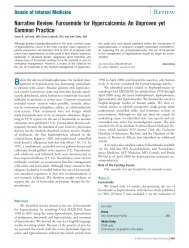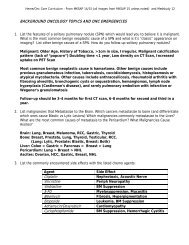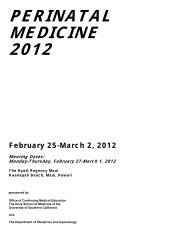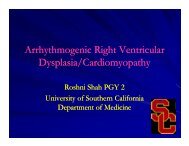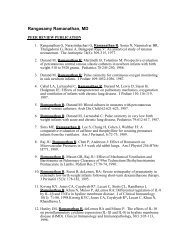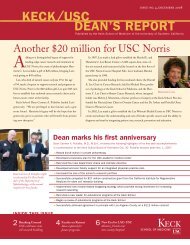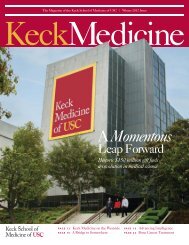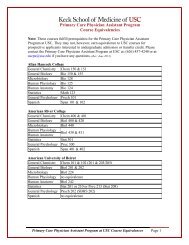Program Book - Keck School of Medicine of USC - University of ...
Program Book - Keck School of Medicine of USC - University of ...
Program Book - Keck School of Medicine of USC - University of ...
- No tags were found...
You also want an ePaper? Increase the reach of your titles
YUMPU automatically turns print PDFs into web optimized ePapers that Google loves.
lower fistula resistance and decreased collateral resistance are likely to augmentretrograde flow in the artery distal to the fistula. These factors are partially compensatedby the decrease in the resistance <strong>of</strong> the inflow artery. More peripherally there must be apoint (presumably at the entrance <strong>of</strong> a large collateral artery) at which the flow becomesantegrade (Figure 3A, point D). In truth, a strict boundary between antegrade andretrograde flow does not exist; there is bidirectional flow with each systole and diastole.Physiologically the location <strong>of</strong> this point is arbitrary, but anatomically this location mayrepresent an area <strong>of</strong> low shear stress at increased risk for accelerated atherogenesis aspreviously described in the particle resonance theory <strong>of</strong> carotid plaque formation. Thiscurious observation was previously made in a published report that described substantialocclusive disease in this segment <strong>of</strong> the artery in all 11 patients in whom the ischemicsyndrome developed chronically after arteriovenous fistula construction. Despite thehemodynamic changes that favor the development <strong>of</strong> steal at the level <strong>of</strong> the artery distalto the fistula, most individuals remain entirely asymptomatic. In fact augmentedcollateral circulation may account for the gradual improvement <strong>of</strong> distal perfusionpressure noted by Lazarides and others. Surgical intervention cannot be recommended forthe mere presence <strong>of</strong> reversal <strong>of</strong> flow, but rather is reserved for patients withsymptomatic, disabling, or limb-threatening ischemia.The following situations can lead to ISS in longstanding AV accesses:Inflow stenosis:Problem: may occur in 20-30% <strong>of</strong> patients with ISS and should be excluded beforepursuing other treatment options.Mechanism: any process that increases the resistance <strong>of</strong> the inflow artery changes theresistance ratios in Table 1 to increasingly favor steal. It is for this reason that selectivearteriography <strong>of</strong> the donor artery remains a critical portion <strong>of</strong> the evaluation beforeembarking on surgical revision to correct symptomatic steal syndrome.Solution: Pressure gradients across any suspicious lesions should be measured.Correction <strong>of</strong> a hemodynamically significant inflow stenosis by angioplasty and/or stentmay relieve ISS symptoms.1156



